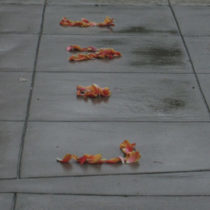Landscape Architecture for Landscape Architects › Forums › GENERAL DISCUSSION › earthquake Japan
- This topic has 1 reply, 12 voices, and was last updated 13 years, 4 months ago by
 Andrew Garulay, RLA.
Andrew Garulay, RLA.
-
AuthorPosts
-
March 13, 2011 at 9:10 am #164157
Andrew Harvey
ParticipantAny thoughts, ideas, information about how landscape architects in Japan can use their skills to help out after the shock? Relief and/or restructuring?
Any organisations/NPOs like Habitat for Humanity & Architects With Out Borders that anyone is aware of in Japan that one could get involved with?
March 13, 2011 at 2:37 pm #164184 Andrew Garulay, RLAParticipant
Andrew Garulay, RLAParticipantI can’t fathom the thought without feeling like a buzzard!
…. send money after the needs are assessed and the relief organizations are in place.
… pray for them if you are religious.
March 13, 2011 at 11:03 pm #164183 Trace OneParticipant
Trace OneParticipantcan we design landscapes that catch the stuctures before they slide into the sea, thus preventing all the incredible debris we throw into the ocean..Although apparently the plastic gyre while frustruting, is apparently not as bad a pollutant as nuclear power plants and air-born toxics..You can make it look pretty – p ossibly, – but you can’t call it quits at that..
March 14, 2011 at 4:50 am #164182 Thomas J. JohnsonParticipant
Thomas J. JohnsonParticipantI think food and water are priorities right now… electricity is down=no water supply. Pipes broken/flooding=water polluted. Roads, rail ways & harbors destroyed = no delivery of food/supplies.
Their needs are very basic at this point… unless you can rapidly deploy mobile desalinization plants and figure out how to launch canned goods 3,000 miles without having them explode on impact or kill people… how cool would that be? Bomb people with food (love) instead of bunker-busters… like rockets you play with in school, the nose pops off, a parachute deploys and a tube of canned food floats down to earth… how many thousands of pounds of food/supplies could we shoot?
March 14, 2011 at 7:26 pm #164181 jennifer BlochParticipant
jennifer BlochParticipantArchitecture for Humanity – Cameron Sinclair has begun organizing his efforts
March 14, 2011 at 8:00 pm #164180 Heather SmithParticipant
Heather SmithParticipantI don’t know. But it is heartbreaking. Anytime I see scenes like this I want to run over and starting shoveling with my hands. 🙁 I think it will be a long time until they get to the rebuilding point.
March 14, 2011 at 9:45 pm #164179 Thomas J. JohnsonParticipant
Thomas J. JohnsonParticipantIt’s unrealistically cost prohibitive to build structures substantial enough to deter tsunamis for all but the most key locations. Even then, if you build a big levy, Mom nature will build a bigger storm. I mean, did you see what that water did!? What would have stopped it?
The best “design” solution is to not build in locations that are only 3′ above sea level… IE most of Southern California / resort destinations… Give the ocean plenty of room and you won’t have these problems… if we leave the natural buffers, such as mangrove forests, intact, they will help protect the shores, prevent erosion, clean the water and provide wildlife habitat… maybe nature is the best designer and we should abide by her rules instead of using expensive and heavy handed methods in an attempt to have our way with her…
Just watch, instead of looking at aerial photos and saying,”OK, that’s the high water mark… lets not build any closer than that…” I guarantee that rebuilding in affected areas will begin as soon as possible…
March 14, 2011 at 10:55 pm #164178 Jason T. RadiceParticipant
Jason T. RadiceParticipantNothing can be done without prohibiting settlement along shores. In much of Japan, high seawalls already existed and were utterly useless againts such a powerful tsunami. Most of the structures (including the nuke plant) were not designed for a quake of such magnitude, and yet they hold up (even the nuke plant is still containing the cores, the radiation is being vented and is less than getting a CAT scan at the moment, the containment vessels have no been breached).
Japan is in possibly the WORST area considering seismology, LA, San Fran and Seattle ain’t much better. Japan has made due by engineering what they can to adapt to minimize damage and loss of life. No amount of design or “trying to beat nature” would have suceeded in this case. The quake was SO HUGE and SO CLOSE to shore, nothing could have been done.
Wishing them all the best in this tragedy.
March 14, 2011 at 11:37 pm #164177 Andrew Garulay, RLAParticipant
Andrew Garulay, RLAParticipantThey out designed the quake, but nothing is going to stop a 30′ wave. Their design and standards are great for earth quakes. This was as extreme as it gets and all indications are that there was little damage from the quake.. As my professor, who happened to be from Japan, used to say “never build in a flood plain” as I type from elevation 20 (not in a flood zone).
March 14, 2011 at 11:44 pm #164176 Heather SmithParticipant
Heather SmithParticipant“Now you know!”
I have to wonder what they could have done. The only things to do are to avoid the areas that are at risk…and even this situation was extreme. Six miles inland? That was a monster quake…extremely close too shore. What are the chances of that? I don’t even know. I do not believe landscape architects have some magic elixir to tame mother nature.
I am from the Seattle area…and although we often hear about “the Big One”…it is still a coin toss of sorts. We all know it will happen. Will it be tomorrow? 50 years? 100 years? As more time goes by it is hard for the next generation to appreciate they may need to build seven miles inland. And what if there was an even bigger Tsunami? Up near Marysville, WA there is a lot of flat, boggy land with sloughs…watching that tsunami rush up I couldn’t help but wonder how protected Puget Sound is?
March 15, 2011 at 2:23 am #164175 Thomas J. JohnsonParticipant
Thomas J. JohnsonParticipantTrace you have really been all over the place lately, are you taking your ADD meds…?
Japan building up to the seashore is not a government conspiracy. We do it all over the place in the US. Japan is a tiny island and needs to make use of every square inch they have available. Have you been up to San O and seen the two nuclear reactors (AKA Dolly Parton) up there? They are on the coast, literally. They dump the hot water directly into the ocean. In fact, only one of the reactors has ever worked. The other one’s foundation settled immediately after construction and has never been used because it might not be safe…. Is that a government conspiracy too…?
How do you go from Japan earthquake, nuclear reactor, environmental building regulations to harbor seals at La Jolla? The reason they don’t like harbor seals is because they attract sharks. Sharks and swimmers (who often wear wetsuits and looks like seals) don’t go well together. Again, it’s not a government conspiracy, La Jolla just doesn’t want people being eaten at their main beach…
Balancing human and environment interaction is all about human safety. It’s best not to build in low lying areas near water and it’s best not to swim with harbor seals in shark infested waters…
March 15, 2011 at 3:28 am #164174 David SpruntParticipant
David SpruntParticipantThe immediate needs of our brothers and sisters in Japan are paramount right now.. Food, shelter, water and consolation.. I’m sure I can ony imagine a fraction of the sense of loss and horror the Japanese people are feeling. If you are able, I encourage you to donate to the Red Cross, an organization that is on site and providing aid right now.
As for the long-term, over the coming years and decades, I think it is likely that rebuilding will occur, maybe not everywhere, but it will happen. Future tsunamis will also happen on these flat coastal plains. Perhaps there is an opportunity for planners and LAs to design tsunami refuges, artificial 40-foot hills made of the non-recyclable debris of this disaster. These mounds could provide safe havens for communities far from natural high ground and serve as memorials for this horrific disaster.
March 15, 2011 at 4:18 am #164173Andrew Harvey
ParticipantThanks all for your input.
I’ll try contacting Architects for Humanity shortly, as well as the architect Shigeru Ban’s office. Ban has worked on numerous relief projects.
I’ve been residing on n’ off in Kobe, Japan- the once booming port city most affected by the Hanshin Quake in ’95- for the past 3 or so years.
During this time I have made some observations and have heard several accounts concerning Kobe’s recovery, most notably that the authorities did next to nothing to help rebuild the city quickly enough for business and indeed life to resume. So most industry picked up and moved to other active and competitive Asian ports, Kobe became nothing much more than a satelite of Osaka (sorry Kobeans reading who may take offence to the satelite comment), and the neighbourhoods that were most gravely impacted, destroyed really, were snatched up by developers, leveled, and more often than not inappropriately scaled high rises and shopping centres built. The results: municipal and prefectural governments have enormous debts, the tax base is now almost entirely residential/property, very few jobs are available, there’s a very high rate of vacant commercial/office space, and traditional neighbourhood life- the social component found in public spaces and shopping streets specifically- has vanished. I have also heard that elderly survivors of the Hanshin Quake who had little choice but to move from their old neighbourhood homes into new high rises became isolated and to this day suicide rates are alarmingly high amongst them.
My account here is simplified and turse, there are other underlying socio-economic and environmental factors, but my basic point is that more sensitive, planning, design and development could have helped Kobe and I am sure can help Tohoku in the long run.
Of course, at this stage water, food, shelter, clothing & medicine is most needed, but I will try to look ahead a bit and think about what can be done to help Tohoku recover and restructure. From the various comments people have left on this forum, I have no doubt that landscape architects can contribute greatly. Keep posting!
At any rate, off to donate blood & $ now. Will do my best to contact other Land8 members in Japan soon.
March 15, 2011 at 5:45 am #164172 Andrew SpieringParticipant
Andrew SpieringParticipantMake a donation via Red Cross here – http://american.redcross.org/site/PageServer?pagename=ntld_main
March 15, 2011 at 2:18 pm #164171 Thomas J. JohnsonParticipant
Thomas J. JohnsonParticipantThe jetty at La Jolla was built to create a protected area for children to swim, hence it’s original name “childrens beach”. The unintended result was that the seals also found it to be a perfect breeding ground and have taken over, hence it’s adopted name “seal beach”. Since it’s a man-made structure that created the conditions for the seals, should La Jolla just remove the jetty? God giveth and God taketh away… Could they build another jetty, in a less desirable area to swim and encourage the seals to move there? Could they build another swimming hole, just for kids and keep the seals out…? Since humans built the alcove it’s not so much an issue of “human population growth” as it is of “original intent”.
-
AuthorPosts
- You must be logged in to reply to this topic.

